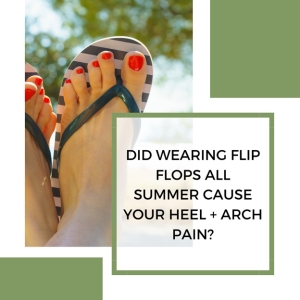Do you love flip flops? Well, hate to break it to you, but they might be the root of your heel pain, a.k.a. plantar fasciitis. Yes, wearing those thin sandals or squishy flip flops all summer long might be the reason why you’re struggling with heel pain this winter. Before you give up on your favorite shoes altogether, read on to learn how to make flip flops work for you – and your feet.
There's no doubt that plantar fasciitis can be a real pain in the foot. The condition, which is caused by inflammation of the plantar fascia (the bands of tissue that runs along the bottom of your foot), can lead to heel pain and stiffness, making it difficult to walk or even stand. Symptoms of plantar fasciitis include:
- Pain and stiffness in your arch or heel, especially in the morning when you get out of bed or if you've been sitting on the couch watching TV, sitting at work or driving for a while.
- However, you may not experience classic symptoms such as pain after standing. Pain in the arch or heel that gets worse towards the end of the day is a very common symptom.
- A feeling that your feet are tired and worn out at the end of the day.
- Many patients that have suffered from plantar fasciitis for a long time can also develop heel spurs.
Treatments for plantar fasciitis normally includes stretching, icing, custom orthotics, steroid injections, prescription and OTC medications, topical anti-inflammatories such as Mod Pod Soothe, and laser therapy. However, we have been hearing a lot about flip flops easing plantar fasciitis pain, specifically that wearing flip flops reduces stress to the Achilles tendon and thus eases the pain.
Unfortunately, in our experience, this is not the case. Flip flops do very little to support the arch of the foot, which is what plantar fasciitis sufferers need. The most important feature that flip flops are missing is rearfoot support. The rearfoot is the “brains” of the rest of the foot. When this isn’t supported, the adjacent structures must compensate and often tighten up, causing not only plantar fasciitis, but potentially Achilles tendonitis as well. In fact, flip flops can actually make plantar fasciitis worse by putting extra strain on the plantar fascia because they are very flexible and lack proper support. So, if you're looking for a shoe to help with your plantar fasciitis, flip flops are not the way to go.
Instead, try wearing a supportive, non-flexible tennis shoes such as Brooks, Asics, or New Balance. I am not saying that you must wear tennis shoes all the time, but if you are going to be on your feet a lot of grocery shopping, cooking, cleaning, or doing laundry, you need to be in a supportive tennis shoe. It is during these high impact times that your feet need the most support. For a comprehensive lists of supportive shoes that are great for plantar fasciitis, you can check out this blog.
If you are just lounging around, you can wear whatever you want – including flip flops. Just don’t wear flip flops to go to the grocery store or go on a long walk. They are not supportive enough and will cause your plantar fasciitis to flare up.
If you’re still not convinced that flip flops are the enemy of anyone with plantar fasciitis, consider this: wearing shoes without proper arch support will cause your feet and calf muscles to work harder than they should, leading to even more pain in the long run. So, if you’ve been struggling with heel pain, it might be time to invest in a good pair of shoes that offer both stability and cushioning. And if you don’t know where to start, our team can help. We specialize in helping people find the perfect shoes for their feet, so call us at 859-264-1141 or schedule an appointment online today and let us help you put an end to your heel pain once and for all.

